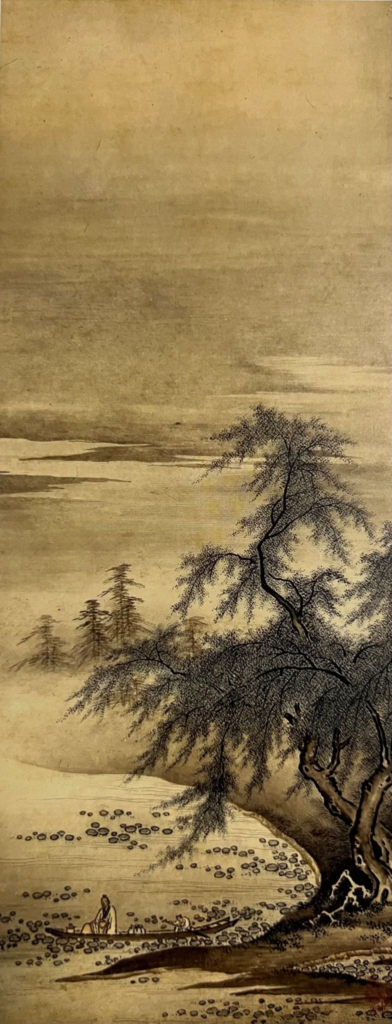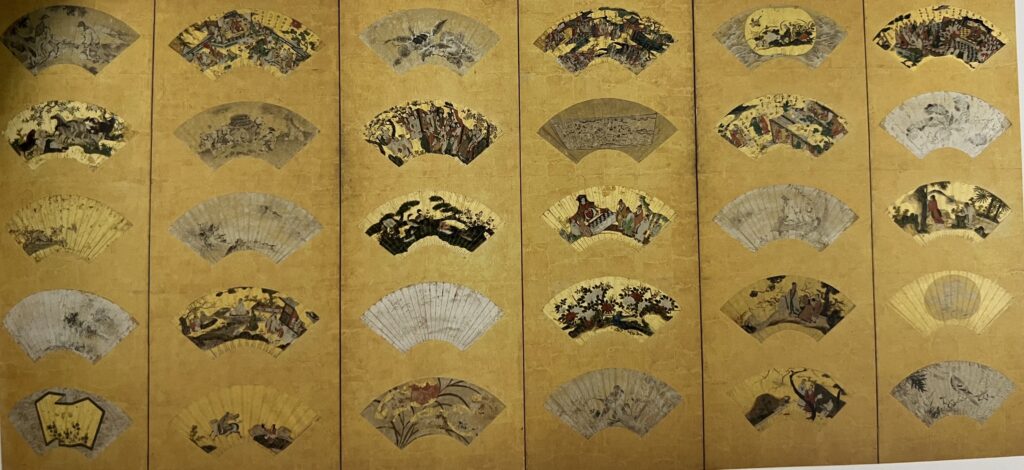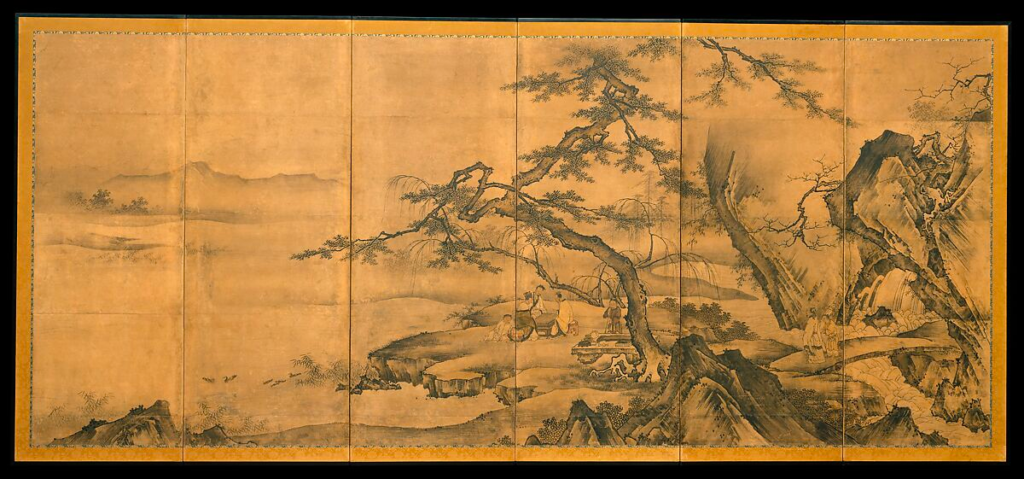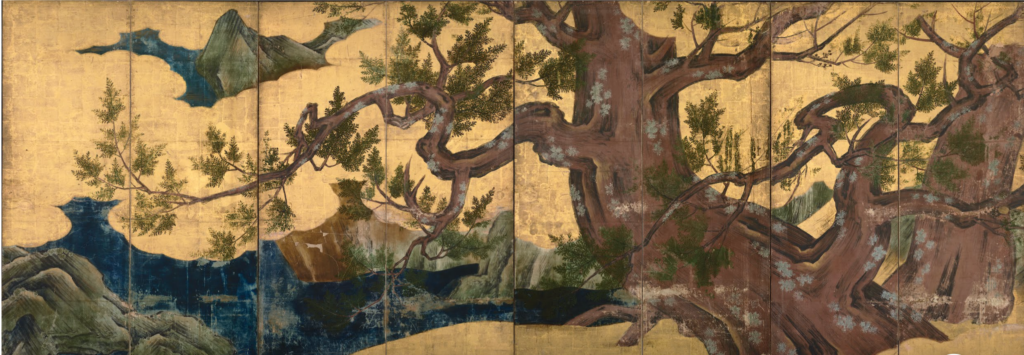Overview:
The Kano school of painting was established by Kano Masanobu. This school was associated with the influential zen temples and adopted the Chinese painting style which had a strong emphasis on brushwork, predominance of ink with little or no use of pigments and preference for Chinese subjects especially images of Zen patriarchs and landscapes. I was drawn to this topic because of the sliding door murals I had seen previously in this class and when I learned about Eitoku I wanted to learn more about his background and from doing some initial research that was how I heard of the Kano School of Art. So I wanted to look at the Kano lineage and other influential painters of the family.
Kano Masanobu:
Kano Masanobu family’s origin is highly debated but it is believed he came from a warrior family. Throughout Masanobu’s life he was credited with creating many different styles of artwork from wall and panel paintings to portraits for members of the Ashiga family as well as painted religious icons for the private use of the shogonal family. Masanobu’s ability to associate himself with powerful patrons was a key feature to the Kano school of paintings’ successful lineage. The painting below is just one of his many artworks done on scrolls depicting a calm state on nature with a smaller portrait of Zhou Maoshu in a boat. This style of worked allowed others to see the talent and variety of skills that Masanobu had. (Fischer, 2015)

Artist: Kano Masanobu (1434-1530)
Ink and color on paper, hanging scroll 33 x 13 inches
Kyshu National Museum, Dazaifu National Treasure
Seal: Masanobu
Kano Motonobu:
Next up in like for the Kano school of art is Motonobu who was responsible for expanding the school during a very challenging time “when the authority of the Ashikaga family had disintegrated and sovereignty over the land passed from one warlord to another” (Fischer, 2015) Motonobu created a new style that combined the ink and brushwork that Chinese paintings had a collaborated it with the decorativeness, color and pattern associated with native Japanese styles. One of his many achievements was the adaptation of small-scale paintings (like fans and albums) associated with specific Chinese masters to large-scale painting formats such as folding screens and panels. (Met, 2000) When he married Tosa Mitsunobu’s daughter he was able to gain a close alliance with a very famous pedigreed painting house and gained new paths to new sources of patronage. He used these to further the school’s successes and previous bonds with the Ashikaga and Hosokawa families and continued to produce portraits and religious icons in bulk. Up until his death he made sure the next successor, his grandson Eitoku, would become a leading painter and continue the strong lineage of the Kano family painters.(Fischer, 2015) The images below show the depth of skill that Montobu worked on from fragile smaller fans to large scale screen. A lot of his commission was done for castles and he was able to depict strength in his paintings through both the actions of people and the details of his nature pieces.

Assembled Fan Paintings
Ink and color and gold leaf on paper, twp of a set of 4 s-fold screens
Each screen 66 x 141 inches
Nanzen-ji Kyoto
Important Art Object

Artist: Kano Motonobu 狩野元信 (Japanese, 1477–1559)
Period: Muromachi period (1392–1573)
Date: mid-16th century
Culture: Japan
Medium: Pair of six-panel folding screens; ink and color on paper
Dimensions: Image (each screen): 67 in. × 12 ft. 6 in. (170.2 × 381 cm)
Classification: Paintings
Credit Line: Dr. and Mrs. Roger G. Gerry Collection, Gift of Dr. and Mrs. Roger G. Gerry, 1991
Kano Eitoku:
While Eitoku’s career was brief (died at age 47) he had an impressive impact on the history of Japanese painting. Eitoku’s development of “picture making suitable to large-scale castle interiors, and to the establishment of a mode of what later histories would call ‘grand painting’ (taiga) and would have a strong influence on painters of the momoyama period”.(Fischer, 2015) He introduced a new strength and dynamism to large compositions that appealed to the warlords who dominated the Momoyama period and fit the decorative desires of the castles created. “His series of sliding doors (fusuma) and the folding screens (byobu) painted with oversize animals, figures, and nature scenes set against scintillating gold foil well illustrated the power and energy the daimyo patrons wished to express.” (Met, 2003). Eitoku’s early death left an uncertainty for the Kano house and it was not until his grandson Kano Tan’yu started emerging as a painter that the Kano house felt restored. Eitoku’s work (for example The Cypress Tree shown below) was nothing short of grand, with the colors, images chosen and the sheer size of his work easily depicting a sense of strength. This and all of his other work give the appeal and desire the warlords were looking for during that time period to decorated the newly formed castles.

Creator: Kano Eitoku
Date Created: Azuchi-Momoyama period, 16th century
Physical Dimensions: w460.5 x h170.3 cm
Type: Painting
External Link:
http://www.emuseum.jp/detail/100144
Medium: Color and gold leaf on paper
Kano Tan’yu
In the 1600 the main branch of the Kano school moved from Kyoto to the new capital of Edo following the Tokugawa shogunate. Kano Tan’yu was the most successful member of the Kano school in the Edo period and named at 15 years old shoguns painter-in-residence and commissioned to decorate many of the most important castles of the day. His praise didn’t just stop there many have referred to hims as “the most-influential Kano painter of the Tokugawa period in Japan.” (Britannica, 2023) He created a style that was more restrained than the grandeur popular during the preceding Momoyama era, incorporating a renewed interest on ink monochrome. Below is just one example of his ink monochrome artwork The Winter Landscape. Tan’yu’s work compared to Eitoku’s shows the drastic change between the generations with the way they depicted their nature landscape. Tan’yu’s more refined and soft approach versus Eitkou’s drastic and harsh contrast of both the trees and mountains shows how when a new leader came into power at the school they were able to redefine the art at that time to depict their style more.

Artist: Kano Tan’yū (Japanese, 1602–1674)
Period: Edo period (1615–1868)
Date: 1662
Culture: Japan
Medium: One from a set of three hanging scrolls; ink and color on silk
Dimensions: 44 1/2 x 15 1/2 in. (113 x 39.4 cm)
Classification: Paintings
Credit Line: Charles Stewart Smith Collection, Gift of Mrs. Charles Stewart Smith, Charles Stewart Smith Jr., and Howard Caswell Smith, in memory of Charles Stewart Smith, 1914
Japan-ness:
When thinking about how my project related to the core idea of this class being Japan-ness I thought of Isozaki’s definition of Jinen: “Japanese life view: an attitude of letting the natural process of becoming decide its own course, that is, intuiting the course of nature and following it.” (Isozaki, 24) With each generation that came into power at the school, they each had their own set of styles that was influenced by the environment around them, so they were acquiring the course of nature and following it, which is Japan-ness. Whether it was Eitoku creating a stronger aesthetics painting for the warlords or Tan’yu ability to bring back the emergence of more simplistic ink monochrome paintings these were both done by following Jinen.
Bibliography
Goodwin, Shauna. “Kanō school.” Grove Art Online. 2003; Accessed 8 May. 2023. https://www.oxfordartonline.com/groveart/view/10.1093/gao/9781884446054.001.0001/oao-9781884446054-e-7000045748.
Department of Asian Art. “The Kano School of Painting.” In Heilbrunn Timeline of Art History. New York: The Metropolitan Museum of Art, 2000–. Accessed 8 May 2023 http://www.metmuseum.org/toah/hd/kano/hd_kano.htm (October 2003)
Fischer, Felice, Kyoko Kinoshita, Yukio Lippit, Masato Matsushima, Shunroku Okudaira, and Aya Ōta. Ink and Gold : Art of the Kano. Philadelphia: Philadelphia Museum of Art, 2015.
Arata, Isozaki. Japan-Ness in Architecture.2003.
The Met. “Winter Landscape .” [cited 2023]. Available from https://www.metmuseum.org/art/collection/search/45698.
Kano Eitoku. “Cypress Trees.” Azuchi-Momoyama period, 16th centuryAvailable from https://artsandculture.google.com/asset/cypress-trees-kano-eitoku/WgG8VxnsSPYalQ?hl=en.
The Met. “The Four Accomplishments .” [cited 2023]. Available from https://www.metmuseum.org/art/collection/search/44673.
Britannica, T. Editors of Encyclopaedia. “Kanō Tan’yū.” Encyclopedia Britannica, February 28, 2023. https://www.britannica.com/biography/Kano-Tanyu.